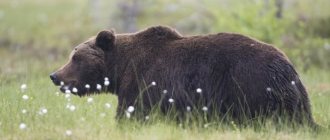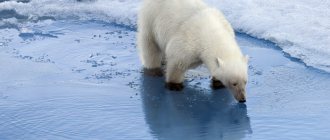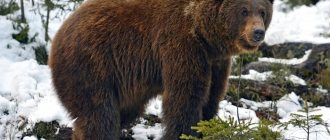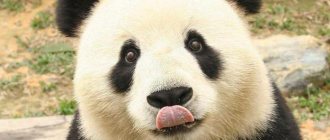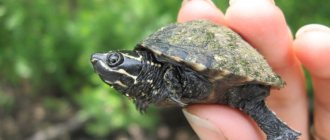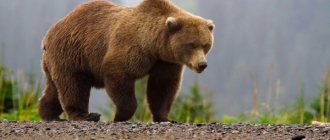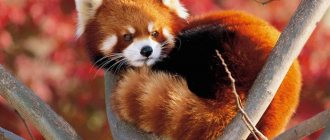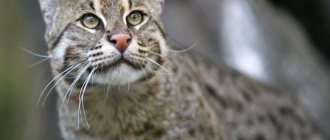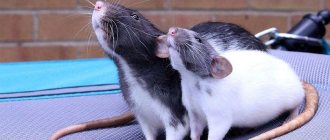Bears: description
The order of carnivorous mammals is associated with a group of marten-like simple predators that lived in the Paleocene and Eocene and are known to scientists as miacids. Bears, regardless of variety, represent a very numerous suborder. Experts suggest that all known representatives of this suborder descended from one common ancestor, which is the main one for similar species of such animals.
Compared to other representatives of predators, bears are considered animals that are distinguished by greater similarity, both in appearance and in size, as well as the features of their internal structure. At the same time, bears are considered one of the largest predatory animals that live on our Planet. Adult polar bears, for example, grow up to 3 meters in length and weigh almost 900 kilograms. Malayan bears, on the contrary, represent the smallest representatives of this family, since they grow up to a length of only one and a half meters and weigh only a little more than 60 kilograms.
Appearance
Adult male bears are typically 20 percent larger than female bears, with polar bears up to 50 percent larger. The animals have a fairly warm and thick coat, with an equally thick and well-developed undercoat. Moreover, the characteristics of the coat largely depend on living conditions. In the Malayan bear, on the contrary, it is very low and rare.
As a rule, the coat color of bears is mostly monochromatic and is represented by charcoal-black and whitish shades. The only exception is the panda, whose color is quite contrasting and made in black and white. In the chest area, as well as around the eyes, lighter tones may be present. Many species are characterized by geographic variability in basic color and coat. In addition, bears exhibit seasonal variability in the quality of their fur, depending on the height and thickness of their fur.
All representatives of this family have a strong and stocky body, as well as a clearly defined and very high withers. To this we can add the presence of powerful and strong paws with five fingers, armed with large and sharp claws. The claws are controlled by powerful muscles, which allows the animal to easily and quickly climb tall trees, dig holes, and also easily handle its prey. In grizzly bears, their length is almost 16 centimeters. The gait of these predators is characteristic and expressed as a plantigrade type, with a peculiar shuffling. In the giant panda, an additional “finger” can be seen on the forelimbs, in the form of an outgrowth of the sesamoid radius bone.
These animals have a short and barely noticeable tail, “hidden” under the fur. As for the giant panda, this cannot be said about it, since the tail of this mammal is quite noticeable and long. Bears, regardless of the species, have relatively small eyes, a fairly large head, and a thick and very powerful neck, but short. The skull is also relatively large, characterized by elongation towards the front part.
Interesting to know! These animals have a well-developed sense of smell, comparable to a dog’s sense of smell, which cannot be said about their vision and hearing, which are an order of magnitude lower.
The cheekbone area is distinguished by some expansion to the sides, which indicates the power of the jaws, which provide fairly high bite force characteristics. All representatives of this family have rather large and sharp fangs and incisors. The remaining teeth differ in that their structure depends on the nature of nutrition. The number of teeth ranges from 32 to 42, which also depends on the individual and age characteristics of the animals.
Interesting facts - Bear
Character and lifestyle
Bears belong to the category of predatory animals that prefer to lead an isolated lifestyle, so they can be seen in a group environment only during breeding periods. Males show aggressiveness not only towards their relatives, but also towards cubs if they stay near the female for a long time. In this regard, females quite often have to protect their offspring from bloodthirsty males. These mammals easily adapt to different living conditions, so bears can be found in mountainous areas, forests, steppes and even in arctic latitudes, with the main differences being solely in their lifestyle and the nature of their food.
Many of the representatives of this family are found on the plains, as well as in mountain ranges of various latitudes with the presence of forest plantations. Some species are found in mountainous environments without dense vegetation. Some species prefer to settle near various bodies of water, regardless of where they are - on the plains, in the mountains or on the sea coasts, even in the Arctic.
Interesting to know! For polar bears, the Arctic, as well as the vast waters of the Arctic Ocean, are considered a natural habitat. As for brown bears, their natural habitats are subtropics, taiga, steppes, tundra, and deserts.
Almost all species of bears are terrestrial predatory mammals with the exception of polar bears, which are considered semi-aquatic representatives of such a large family, as well as Malayan bears.
Malayan bears prefer to lead a semi-arboreal lifestyle, so they feel at ease in the treetops and even build a nest for themselves at a height. There are species that live within burrows formed by the root system of trees, and also use various crevices, including caves formed by piles of stones.
The Bear family is mainly active at night, staying in their shelters during the day. As for polar bears, they do not fit into the general rules, since they can be seen in groups not only during breeding periods. They can go out in groups to watering places, and in groups they can also look for food for themselves.
How long do bears live?
Their lifespan depends on their species, which is also related to their habitat. Their lifespan ranges from:
- Spectacled bears live on average about 2 decades.
- The life expectancy of Apennine brown bears is within twenty years, no more.
- The life of Tien Shan bears is limited to a maximum of a quarter of a century.
- Polar polar bears can live more than 25 years.
- Sloths live a little less than 2 decades.
As for keeping bears in captivity, if properly cared for and maintained, representatives of this family can live for more than 4 decades.
Pseudobears
The peasants of China called the giant panda a bear long before scientists. Some zoologists still classify the animal as a raccoon. The working people of the Celestial Empire always called the panda a bamboo bear. However, confusion arises because there is also a red panda.
Little panda
Unlike its big brother, it is classified as a panda. The verdict was also the result of genetic testing. It showed that the red panda is not related to bears or raccoons. The animal is similar in character to the latter.
The red panda is friendly and easy to tame. There are also external similarities with raccoons, for example, a tail, an elongated body, and sharp ears. The red panda resembles bears in its full-footed gait and, again, in its external features.
The size of a small panda is comparable to a large cat. Because of its dexterity in climbing trees, the animal is called a cat bear. The popular nickname cannot be changed, no matter what scientists say.
Koala
It is called a marsupial bear. The epithet in the name is true. The koala truly belongs to the marsupials, a class of protozoan mammals preserved only in Australia.
The name of the animal is similar to the name of the family to which it is assigned. There are no other members of the family. This, by the way, also applies to the red panda. She is also one of a kind.
The koala's closest relative is the wombat, and not a bear or even a red panda.
About 30 million years ago, 18 species of marsupial “bears” lived on the planet. There were also true club-footed people, unseen by modern man. Among them, 5-6 species became extinct.
Types of bears with photos and names
Depending on the species, despite the characteristic similarities of various members of the family, they have noticeable differences associated with the nature of their appearance, as well as the nature of their behavior and the type of their life activity.
Scientists know about the following types of bears:
Spectacled or Andean bear (Tremarctos ornatus)
It is distinguished by its impressive size, with a body length of almost 180 centimeters and a weight of up to one and a half hundred kilograms. The animal's coat is charcoal-black or blackish-brown in color. Around the eyes there is a wide border of white or yellowish tint, which is connected to a hemisphere of the same shade in the throat area.
Brown Siberian bear (Ursus arctos collaris)
The average weight of this animal reaches half a ton, with a body length of 2 and a half meters. The base color can vary from fawn to dark brown. The animal's paws are armed with long and strongly curved claws, brown or blackish-brown in color.
Grizzly bear (Ursus arctos horribilis)
The grizzly bear is a continental species, which is characterized by the presence of common characteristics representing size, color and lifestyle associated with natural habitat conditions.
Apennine brown bear (Ursus arctos marsicanus)
The Apennine brown bear is a medium-sized subspecies, with an average weight of no more than one and a half hundred kilograms.
Kodiak (Ursus arctos middendorffi)
The Kodiak bear is a real monster, growing in length to almost 3 meters, gaining weight to almost 800 kilograms. It is distinguished by a compact but muscular body, as well as strong and relatively long legs. These animals have a fairly voluminous head and a very short tail.
Tien Shan brown bear (Ursus arctos isabellinus)
The predator belongs to a separate species, the average size of which is within 1.4 meters, and its weight reaches 300 kilograms. The subspecies has long, light-colored claws with which its front paws are armed.
Tibetan brown bear (Ursus arctos pruinosus)
The Tibetan bear or pika bear is one of the rarest subspecies of brown bear. The animals are distinguished by a light red head, as well as a muzzle painted in lighter colors, while the mammal’s chin is brown, as are its dark brown ears.
Gobi brown bear (Ursus arctos gobiensis)
The Gobi brown bear (Mazalay) is considered a relatively medium-sized subspecies, the main color of which is light brown or whitish-bluish, while the fur of the predator is quite coarse and sparse.
Polar bear (Ursus maritimus)
The white (polar) bear is considered the largest predator of this family. Its length reaches 3 meters, and its mass is almost a thousand kilograms. The polar bear has a relatively long neck and a head that is more flat than round. Despite the fact that the animal's coat is pure white, the bear's skin is black.
Himalayan bear (Ursus thibetanus)
The Himalayan or white-breasted bear is characterized by the peculiarities of its physique. It is slender, and its muzzle is thin and pointed. The bear's ears are large and round in shape. The predator grows up to a maximum length of 0.9 meters with an average weight of up to 140 kilograms.
Slothfish (Melursus ursinus)
The sloth bear or sloth bear is characterized by having a unique appearance, uncharacteristic of this family. Adults reach a size of 180 cm and can weigh on average 100 kilograms. These animals have a very massive body, high legs and a large head with a flat forehead, turning into an elongated muzzle. The animals are distinguished by the presence of long and shaggy hair, which forms a kind of mane in the area of the shoulders and neck.
Malayan bear (Helarctos malayanus)
The Malayan bear (biruang) is one of the smallest predators of this family. Adults grow up to one and a half meters maximum, gaining weight no more than 70 kilograms. Despite its size, it is a strong and stocky animal, with a short but wide muzzle. The coat is hard, short, but smooth, black in color, while on the face you can see splashes of a yellow-roan tint.
Interesting moment! Many experts prefer to attribute the panda to the Raccoon family, but not to the bear family. The status of the grizzly bear is also in question, since this species was previously identified as a separate species.
Scientists also know about extinct species, of which there are not so few. Extinct species include Florida cave bears, giant short-faced bears, lesser short-faced bears, Atlas bears, California brown bears, Mexican brown bears, Etruscan bears, cave bears and lesser cave bears.
Cowardice
If you take a bear by surprise in this state, he can easily display cowardice that is very shameful for his massive body.
Hunters know that sharp noise can easily cause a real intestinal upset for a bear. And it is from this quality that the phrase “bear disease” comes from.
Natural habitats
Spectacled bears are considered the only animals of the Bear family that prefer to live within South America. Their natural habitats extend to mountain forests in countries such as Venezuela and Ecuador, Colombia and Peru, Bolivia and Panama. Brown bears are more characterized by habitat conditions associated with the basins of rivers such as the Lena, Kolyma, Anadyr, as well as with Eastern Siberia and the Stanovoy Range. They can be found in northern Mongolia, in some regions of China, as well as in the border areas of eastern Kazakhstan.
Typical natural habitats for grizzly bears are western Canada and Alaska. A small number remains in continental America, more precisely in the state of Montana and northwestern Washington. For their life activities, Tien Shan brown bears preferred the Tien Shan mountain ranges and the Dzungarian Alatau, which is connected by peripheral mountain ranges. Mazalai bears prefer to live in the Tsagan-Bogdo and Atas-Bogdo mountains, overgrown with sparse bushes and the presence of old dried up river beds.
Polar bears are distributed over vast areas adjacent to the polar latitudes of the northern hemisphere. Himalayan bears are typical inhabitants of the mountain forests and hills of Afghanistan, Iran, Pakistan, including the Himalayas, extending to the border areas of Japan and Korea. In the summer, they climb the mountains to a height of up to 3 thousand meters, or even more, and with the onset of winter cold they return back to the foot of the mountains.
Sloths can be found in the tropical and subtropical zones, which extend into the forested areas of countries such as India, Pakistan, Sri Lanka and Nepal, including countries such as Bhutan and Bangladesh. Biruangs are typical inhabitants of northeast India and Indonesia, including the islands of Sumatra and Kalimantan. On the island of Borneo there is a Malayan bear, also known as the Biruangi bear.
Brown bear - interesting facts
Lifestyle
All types of bears, with the exception of the white one, lead a sedentary lifestyle. They try to live either alone or in small families (a mother bear with cubs). Each bear has its own territory in the forest, where it lives and hunts. In winter, bears go into hibernation, which is one of the characteristic features of these animals.
The role of bears in the global ecosystem
Like many other species of animals, the Bear family plays a significant role in the functioning of the ecosystem of our Planet, due to the characteristics of their diet, depending on their habitat. Since “Bears” are typical predators, they take part in regulating the number of various animals that live in the same territory as predators such as bears.
Interesting Facts! As a rule, bears of various species harbor various external parasites, as well as many endoparasites.
Herbivorous species contribute to the natural process of seed dispersal of various plants. Arctic foxes prefer not to go far from polar bears in order to eat the remains of food left by these predators.
Cubs discussion
The most popular theme for photo hunters is bear cubs. The bear cub is always friendly and spontaneous, so photos with their participation are always a success.
But these two didn’t share something, but the mother in the background goes to resolve the kids’ dispute.
What do bears eat
Spectacled bears are considered the most herbivorous representatives of the family, the basis of their diet consists of grass shoots, fruits and roots of various plants, and corn crops. Somewhat less often, they eat various insects, mainly ants and termites.
The basis of the diet of Siberian bears is fish, and the Kodiak bear belongs to the category of omnivores, therefore its diet contains components of both animal and plant origin, including carrion.
Tibetan bears (pisch-eating bears) mainly feed on plant foods, as well as pikas, which is where their name comes from. The diet of polar bears includes food items of animal origin such as ringed seals, bearded seals, walruses, seals and other marine animals. At the same time, polar bears do not refuse carrion, which can be dead living organisms, as well as eggs and chicks of various species of birds that live in the same territory as polar bears. At the same time, polar bears eat seaweed and grass, and when close to humans, they visit various garbage dumps in search of food.
The diet of white-breasted and Himalayan bears mainly consists of plant foods, but bears also happily eat ants and other insects, including mollusks and frogs. Sloth bears, like anteaters, are more focused on termites and ants. Almost all biruangs are characterized as omnivorous predators, whose diet includes both insects and objects of plant origin, in the form of fruits and shoots of various plants, as well as their root system.
Incomprehensible Russia
For many residents of Western Europe and the United States, this amazing photo shoot causes genuine horror and bewilderment, and often misunderstanding.
But this is Russia, unique and inimitable, where natural beauty harmoniously fits into the landscapes of wild nature.
In addition, there are several other famous photo shoots where beautiful girls pose with a live bear.
Reproduction and offspring
Upon reaching 3 or 4 years of age, bears are ready to breed, but this does not mean that from this period bears actively mate. In fact, this process is associated with a certain natural interval, which can range from one to 4 years. Most likely this is due to the characteristics of living conditions, including a very important factor, such as the availability of food. The female carries her offspring for a maximum of 70 days, although there may be some delay in the process of implantation of fertilized eggs, which can significantly prolong the pregnancy process. A female can give birth to a maximum of 5 cubs. If bears hibernate, then the birth of offspring takes place in the winter, directly in the den.
As a rule, animals do not form pairs for life, since males do not take any part in the development and upbringing of their future offspring. The female feeds the cubs with milk for 3 to 9 months, while the young remain with the females until they are one and a half years old. Individuals become sexually mature upon reaching 3–6 years of age, while the maturation processes do not stop until the age of 10.
For some species, a characteristic feature is the death of individuals that have not reached sexual maturity. Early mortality in baribals is at least 50 percent, while in polar bears this figure averages 20 percent. Moreover, about 15 percent die before reaching sexual maturity. The result is no less than 35 percent, which is not so little, given the harsh natural living conditions and other factors.
What does he look like?
On average, the size of the body can reach two meters. The length of the tail varies from 6 to 20 cm. The bear's fur is thick, allowing it to withstand various weather conditions. Developed paws are a deadly weapon. The feet are wide and well adapted.
The largest representatives live in the Far East and Kamchatka. The maximum weight of an animal reaches 600 kg, and the average is 150-400.
By autumn, the clubfoot accumulates subcutaneous fat in order to prepare for the coming winter. Such preparations are fraught with an increase in weight by 20-25 percent of the original.
Population and species status
The spectacled bear has been listed in the IUCN Red List; its numbers are relatively small and there is a high probability that the species may disappear forever. The Kodiak bear was also taken under state protection, since its population had also declined significantly due to uncontrolled hunting. Apennine brown bears are on the verge of complete extinction, since no more than 80 representatives of this species remain in the natural environment.
Tien Shan brown bears are also rare species these days. Their numbers are declining at a rapid rate, so bears are protected in the Aksu-Dzhabagly and Alma-Ata nature reserves. For the sake of obtaining bile, which is used in Chinese medicine, food-eating bears are actively exterminated, although at present their official conservation status of such animals has not been determined. This is mainly due to a lack of information.
Gobi bears are not only classified as "very rare animals", but are also considered a highly vulnerable species, which has led them to the brink of extinction. As for polar bears, they are also listed in the International Red Book, including the Red Book of our country. The vulnerability of the species is due to the fact that polar bears do not reproduce as quickly as we would like, and many of them die before reaching sexual maturity.
It is important to know! One of the subspecies of the Himalayan bear, the white-breasted Balochistan bear, is also listed in the Red Book, as it is on the verge of complete extinction.
Sloth bears are also listed in the IWC, with the status assigned to them as “endangered”. The fate of the Biruanga is no less tragic, since this species is considered not only rare, but also very vulnerable.
Soviet postcards
Now let’s move on from the photos of bears directly to pictures. The image of a good-natured bear was the most popular on postcards of the Soviet period.
It is noteworthy that beautiful bears were suitable for both birthday greetings and New Year holidays.
Modern cards are also distinguished by their warmth and charm. Bears are still very popular.
Man and bears
Since bears belong to the category of predatory animals, people should avoid them. Large grizzly bears are characterized by the fact that there are known, although very few, cases of attacks by these animals on humans. Their victims are mainly tourists who break many rules and try to feed wild animals. In addition, especially recently, these predators have begun to be attracted to large landfills filled with food waste. If you disturb a grizzly bear in the process of his search for food, then problems will not be long in coming.
In cases of encounters with Himalayan bears, one cannot count on a peaceful outcome; moreover, there are many cases known, including those with disastrous outcomes.
Brown bears. Documentary.
Grizzly
The formidable Grizzly predator lives mainly in Alaska and the islands adjacent to the peninsula. It can also be found on the west coast of Canada and some US states.
It is noteworthy that George Ord, who gave this animal the nickname Grizzly (translated as “formidable, terrible”), had never seen this bear in his life.
7
Be-be-bear Kesha
Among modern cartoons, “Be-be-bears” are actively becoming popular. Every kid will want to add one of the characters to their art collection. Below is a master class: “how to easily draw Kesha”?
It is worth preparing a helium pen and markers.
- Draw an oval for the muzzle. It should have slightly square features, with ears on top.
- In the middle of the hero’s head we draw another small oval. This is the future nose.
- Draw the eyes. You need to show highlights on them. We paint over everything around except them.
- Let's move on to the body. We draw two lines from the head. They should widen slightly towards the bottom. Next, we connect them with a horizontal sausage.
- We draw the upper paws and claws.
- We draw the blouse, tummy and two legs of the character. On the jacket you can depict a picture in the form of a mesh.
- All that remains is to color everything. Kesha himself will be brown. The nose, mouth, inner parts of the ears, bottom of the paws and claws are dark brown. We make the sweater blue. Your child will definitely appreciate the work.
Each drawing can be made unique, just add your own twist to it. Bears can be drawn in motion, when they lie, raise their paws, whatever you like. In creativity, it is not necessary to be a certified specialist; what is important here is the ability to grasp the necessary detail and grasp the meaning.
The desire to discover and learn something new. Few people can boast of a perfect rendering of the drawing the first time. This is why a master class and various step-by-step instructions have been created. You need, as they say, to get better at it. All comes with experience. This also applies to art.
